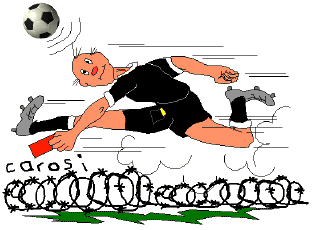| |
 |
TRAINING GUIDELINES
Preparing and Training…Staying Free of Injury
Andrew Castiglione
Founder of Ken Aston Referee Society
 |
STAYING FREE OF INJURY
BUILD UP THE WORKLOAD... S L O W L Y
TRAINING GUIDELINES |
 |
STAYING FREE OF INJURY
Training must be thought of principally in terms of prevention of
injury.
Fact – Lack of fitness is one of the prime causes of
injury.
The amount of time spent on training depends on the level at which you
Referee, and the state of your physical condition. If you begin
pre-season training ten pounds overweight or in a ‘flabby’ condition you
will require a longer and more intensive program than a colleague who is
already in a reasonably good state of fitness.
– The
most dangerous period is the first few weeks of the season.
Reasons for this include:
 - Inadequate pre-season training
- Inadequate pre-season training
 - Muscles are not as flexible as they should be
- Muscles are not as flexible as they should be
 - Overweight
- Overweight
 - Refereeing before you are fit enough
- Refereeing before you are fit enough
A player hardly ever injures a Referee and any condition caused by
direct contact would be sheer bad luck. You are most likely to suffer
muscular injuries involving muscle pulls or ruptures. The muscles most
likely to be affected are the muscles of the thigh and lower leg as well
as the Achilles tendon.
Fact - Poor
abdominal and back strength is a major cause of back injury.
You need to work regularly (at least 3-4 times per week) on developing
your abdominal and lower back strength and conditioning, and should
include exercises for this purpose whenever you train, or on the floor
at home on a non training day.
There are lots of different exercises designed to strengthen the trunk
muscles. Here are a few of the more common exercises.
– Try to
perform at least 12 repetitions of each exercise. As you become stronger
perform up to 25 repetitions and repeat up to 3 times.
Breath freely throughout
each repetition.
BUILD UP THE WORKLOAD SLOWLY
TRUNK CURLS
Lie on your back with your knees bent to 90 degrees and feet
flat on the floor (not held).
Slowly curl the shoulders off the ground and then sit up,
directing your elbows towards the hips.
Pause at the top position and squeeze the abdominals. Slowly
return the shoulders to the floor after each sit-up. |
 |
 |
SIT-UPS WITH A TWIST
Lie on your back with your knees bent to 90 degrees and feet
flat on the floor.
Place your hands behind your head and sit up to touch your right
elbow to your left knee and vice versa. |
BACK EXTENSIONS
Lying on your front, hands linked behind your back. Raise your
trunk off the ground to arch your back whilst keeping your hips
on the floor. Hold for the count of 10. Return to the starting
position. |
 |
 |
‘SUPERHEROES’
Lying face down, raise your left arm and your right leg at the
same time. Pause at the top and then lower under control.
Repeat with the opposite side. |
Regular stretching and
strengthening of your muscles,
Will help prevent those
niggling injuries,
That so often detracts from
your performance, psychologically and physically.
TRAINING GUIDELINES
Follow these simple Training Guidelines to improve your
fitness and remain free from injury.
1. Don’t work too hard too
soon. Improvements in fitness take time. If you rush your progression
you may injure yourself. The primary objective is that you stay injury
free, so don’t over-train.
2. Try to vary your
training so you alternate hard and easy days.
3. All sessions should
start and finish with a warm up/down followed by stretching.
4. Always train within
your training zone (i.e. 70% - 90% of maximum heart rate).
5.
Do not train if your are ill.
6. If you are injured, try
and substitute training for activities such as cycling or swimming to
help you maintain your fitness.
7. Invest in decent
clothing and footwear. It is important to wear good shoes especially
when training on hard surfaces.
8. Don’t jog in fog.
9. If you go jogging in
the dark always wear light colored clothing so you can be seen easily.
Better still, wear a reflective jacket.
10. Don’t eat, drink
caffeine or use tobacco products within 2 hours of a game or a training
session.
11. Regularly consume
water before, during and after training and matches.
Source of information: 'A Guide to
Fitness for Referees' April 2001, produced by the Football Association
England. Acknowledgement to the National Coordinator for Fitness
Training, Vernon Crew; along with expert advice from John Brewer,
Director of the Lilleshall Sports Injury and Human Performance Center;
Alan Hodson, Director of the Football Association Medical Education
Center; and Rob Hartley, Head of the Sports Science Department,
University of Brighton.
|